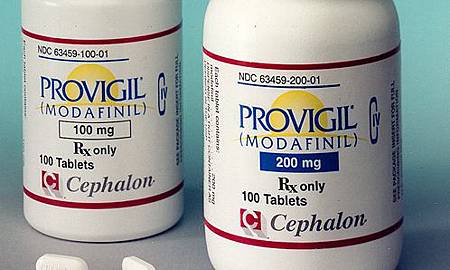
之前也有跟各位介紹過這顆藥,本篇只是文獻摘要
Modafinil
American Family Physician. Kansas City: Sep 1, 1999. Vol. 60, Iss. 3; pg. 973
Narcolepsy is characterized by somnolence, which is often accompanied by sudden attacks of weakness (cataplexy) when awake and sometimes by hallucinations or paralysis before falling asleep or on awakening. Nap therapy and central nervous system stimulants such as methylphenidate and d-amphetamine are used to treat somnolence, and antidepressants are used to treat cataplexy. Modafinil is a benzhydryl sulfinylacetamide non-amphetamine stimulant that has been used in Europe since 1994 and is now labeled by the U.S. Food and Drug Administration for treatment of excessive daytime sleepiness associated with narcolepsy. Consultants for the Medical Letter on Drugs and Therapeutics reviewed the efficacy and safety data for the use of modafinil.
The mechanism of action of modafinil is unknown, although in animal studies the drug acts on areas of the brain involved in sleep/wake and biologic clock regulation. In animals, it increases activity without causing agitation. Alpha,-adrenergic antagonists attenuate its wakefulness-promoting effect. Modafinil is rapidly absorbed, reaching peak levels within two hours.
Modafinil is metabolized in part by CYP3A4, so concurrent use of any 3A4 inducers, substrates or inhibitors could affect concentrations of the drug as well as the duration of its effect. It is also a reversible inhibitor of CYP2Cl9 and may increase concentrations of such drugs as clomipramine.
In two nine-week double-blind, placebocontrolled studies of about 550 patients with narcolepsy, 200 or 400 mg of modafinil taken once daily led to clinically significant improvement compared with placebo in several standard measurements of daytime sleepiness, but only to about 50 percent of normal. Methylphenidate and d-amphetamine have been reported to bring daytime wakefulness to about 70 percent of normal. In another study, about 25 percent of patients reported loss of effectiveness with modafinil, which could not be reversed by raising the dosage, after a mean duration of two years' use.
Modafinil is generally well tolerated and does not appear to affect nighttime sleep. Common adverse side effects include headache, nausea, diarrhea, dry mouth and anorexia. Although direct comparisons with methylphenidate or d-amphetamine are not available, modafinil appears to produce less nervousness, anxiety and insomnia. Chest pain, palpitations, dyspnea and transient T wave changes have been reported in general populations, and dyskinesias have occurred in elderly patients. Modafinil can produce psychoactive and euphoric effects equivalent to those produced by the amount of caffeine in two cups of coffee. One patient developed symptoms of psychosis with a dosage of 600 mg per day. Withdrawal symptoms and dependence have not been reported, and the drug appears to have less potential for abuse than methylphenidate or d-amphetamine.
Modafinil is available in 100- and 200-mg tablets. The recommended dosage is 200 mg per day taken as a single dose in the morning. The dosage should be reduced in patients with severe hepatic impairment and possibly in elderly patients. The cost to the pharmacist for 30 200-mg tablets is $145.50.
Consultants for the Medical Letter conclude that modafinil appears to be moderately effective and well tolerated for treatment of daytime sleepiness in patients with narcolepsy. Although direct comparisons are lacking, it may have less potential for abuse than methylphenidate or d-amphetamine.
BARBARA APGAR, M.D., M.S. Medical Letter consultants. Modafinil for narcolepsy Med Lett Drugs Ther March 26, 1999;41(1049):30-1.
或是順便看看人瑋藥師的介紹:http://goo.gl/YHjlf





 留言列表
留言列表
 線上藥物查詢
線上藥物查詢 